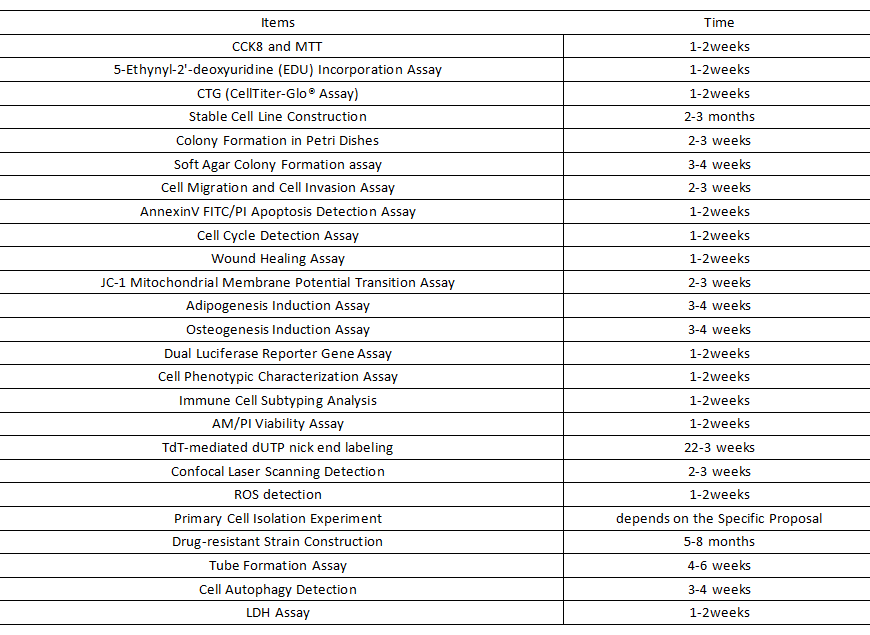Pre-clinical CRO Service
Cell functional genomics platform
Basic Information
Jennio offers functional genomics platform services including stable transgenic strain construction, cell proliferation assay (CCK8, MTT, EDU, colony formation assay ), cell toxicity testing, cell apoptosis assay (TUNEL, Annexin V FITC), cell cycle analysis, cell migration and invasion experiment, JC-1 staining, lipid induction assay, tube formation assay, dual luciferase reporter gene system, magnetic bead-based immune cell sorting, flow cytometry cell identification, laser confocal microscopy for fluorescence expression, and primary cell isolation, etc. With excellent experimental reproducibility, professional technical expertise, and comprehensive service system, Jennio provides solid support for your scientific research.
Services We Provide
1.Cellular Functional Experiments
1.1 Soft Agar Colony Formation Assay
Soft agar colony formation is employed to detect the clonogenic capacity of tumor cells. It is commonly used to assess tumor cell proliferation or the presence of residual tumor cells in cell therapy products.
1.2 Cell Proliferation and Cytotoxicity Assay
1) Cell proliferation assays, including CCK-8, MTT, EDU, CTG, and colony formation assays, can be used to assess the viability of cells in vitro.
2) Cytotoxicity detection includes CCK-8, MTT, and CTG assays.
1.3 Cell Migration and Invasion assay
The invasion or migration ability of cells can be evaluated through the transwell assay, while the migration ability of cells can be assessed using the wound healing assay.
1.4 Flow Cytometry
1) (AnnexinV FITC/PI Apoptosis Detection)
2) (PI法)PI Staining for Cell Cycle Detection
3) Cell Phenotyping Assay
4) Immunophenotyping Identification
5) Mean Fluorescence Intensity Analysis
6) ROS (Reactive Oxygen Species) Detection
7) AM/PI Viability Assay
8) JC-1 Mitochondrial Membrane Potential Assay
1.5 Magnetic Bead Sorting and Expression Identification
Isolation of PBMC for Magnetic Bead Sorting to Assess Immune Cell Expression
1.6 Stem Cell Induction
Assessing the differentiation potential of stem cells through osteogenic and adipogenic induction experiments.
1.7 Tube Formation Assay of Cells
Detecting tube formation rate of cells under different conditions.
1.8 Dual-Luciferase Reporter Gene
1.9 Other Functional Experiments
For special protocols or other experiments not mentioned, please consult our technical personnel.
2.Cell Line Construction
2.1 Isolation and Culture of Primary Cells
The techniques for isolating primary cells include the isolation and culture of neurons from the cerebral cortex and cerebellum, dorsal root ganglion (DRG) neurons, renal tubular epithelial cells, mesenchymal stem cells, CD4+/CD8+ T cells, mouse liver cancer cells, etc.
2.2 Stable Cell Line Construction
Stable Cell Line refers to a cell line that has been genetically modified to overexpress or suppress specific genes. The construction of stable cell lines can be achieved using a lentiviral drug screening system known as "lentiviral infection-drug selection method," or a transposon screening system, including the construction of overexpression stable cell lines, knockdown stable cell lines, or stable cell lines with disease-related gene.
2.3 Drug-resistant cell lines construction
Drug-resistant cell lines construction can be achieved through methodologies such as high-dose drug shock method, increasing drug concentration method, and a combination of increasing drug concentration and high-dose drug shock method.
2.4 Cas9 Genome Editing Cell Line Construction
The CRISPR/Cas9 system consists of a single guide RNA (sgRNA) and a Cas9 protein with endonuclease activity. The technical principle involves two basic processes: sgRNA-guided Cas9 targeting DNA cleavage and DNA repair. The advantages of CRISPR/Cas9 technology are the ability to permanently alter the genomic DNA sequence and the ability to edit non-coding DNA regions. It also allows editing at multiple locations simultaneously.
Cell lines constructed by knocking out the target gene using Cas9 genome editing technology can be used in gene function research, disease model construction, gene therapy, and other fields, which has broad application prospects.
3. Cellular experimental instruments detection
3.1 Enzyme-linked Immunosorbent Assay (ELISA) for Optical Density (OD) Measurement
The OD value is measured using different excitation wavelengths.
3.2 Chemiluminescence Assay for Detecting Endogenous Luminescence
The technology can be used to detect ATP, luciferase, and other chemiluminescent substances. It has the advantages of high sensitivity and high efficiency.
3.3 Fluorescence Microscopy for Detecting Fluorescent Expression
Observing cellular fluorescence expression under the microscope.
3.4 In Vivo Imaging System for Detecting Fluorescent Stable Cell Line Construction
Recording cellular fluorescence values using an in vivo imaging system, which provides a visual and rapid method.
3.5 LSM800 Laser Scanning Confocal Microscopy for Detecting Fluorescent Expression
Using LSM800 for laser scanning confocal microscopy to detect fluorescence expression enables high resolution imaging and precise fluorescent localization.
3.6 Becton Dickinson (BD) Flow Cytometer
Cell fluorescence can be detected in four channels using the BD flow cytometer.
Procedure of Services
1.Determination of experimental scheme
Based on the customer's proposal and requirements, our company can provide suggestions to further improve the plan and carry out relevant experiments.
2.Overall time for experiment

3.Project Delivery
1)Report: All the data and images will be organized and submitted in the form of report when the experiment is completed.
2)Figures: All raw data and images will be delivered to client.
3)The physical delivery: All experimental samples involving physical materials will be collected and delivered to the client upon completion of the experiment.
4)Project Feedback
After the completion of the experiment, any questions or concerns regarding the experimental process, procedures, and results from clients, our company will provide assistance and offer technical guidance.
Features
1.One stop integrated services
With over 800 strains of cell lines in our cell bank, we have complete resources of seed stocks and provide end-to-end services for your research.
2. Professional technical support
We serve a large number of research institutes and corporate entities across the country. Our laboratory personnel have more than 10 years of experience.
3.On-time delivery
For each experiment, we have a well-established experiment management and feedback system (VR mini-program progress record) to ensure project punctuality and efficient feedback.
4.Professional technical guidance
We have a professional service team that provides expert advice and guidance on experimental techniques, ensuring smooth progress for researches.
Our Laboratory

